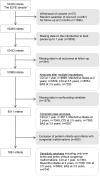Timing of food pieces introduction and neurodevelopment: findings from a nationwide birth cohort
- PMID: 39415260
- PMCID: PMC11481772
- DOI: 10.1186/s12966-024-01669-5
Timing of food pieces introduction and neurodevelopment: findings from a nationwide birth cohort
Abstract
Background: While complementary feeding can be challenging, little emphasis has been placed on the introduction to food texture/pieces, especially in terms of neurodevelopmental outcomes. This study aims to determine the association between the timing of introduction to food pieces during infancy and neurodevelopment in early childhood. We hypothesized that late introduction to food texture/pieces relates to unfavorable neurodevelopmental outcomes.
Methods: Families (n = 18329) were recruited from the general population during the nationwide ELFE (Étude Longitudinale Française depuis l'Enfance) birth cohort in France, and 8511 were selected for a complete case analysis. Age at introduction to food pieces was determined based on repeated assessments during the first year. A range of neurodevelopmental outcomes among children were assessed using validated instruments, i.e. composite scores at 1 and 3.5 years, and a score for language acquisition at 2 years. Risk for developmental delay at 3.5 years was defined based on a developmental quotient (DQ) below 90 according to the child's chronological age and the respective composite score at this age. We used linear regression modelling to evaluate associations between age at introduction to food pieces and the standardised neurodevelopmental scores, while logistic regression models were used in the analyses according to the risk for developmental delay.
Results: Our findings highlight consistent associations between late introduction to food pieces (i.e., after 10 months, compared to early (before 8 months)) and lower estimates of standardised neurodevelopmental scores at ages 1, 2 and 3.5 years (-0.35 [-0.40; -0.30], -0.15 [-0.20; -0.10] and - 0.18 [-0.23; -0.13], respectively). Infants introduced to pieces late were also more likely to be at risk for developmental delay according to DQ < 90 (OR [95%CI] = 1.62 [1.36; 1.94]).
Conclusions: This study shows that late introduction to food pieces (> 10 months) is related to lower neurodevelopmental scores. Given the challenges that complementary feeding may pose, concerted efforts are required to enhance our understanding of the sensory aspects of early diets and to ultimately provide guidance.
Keywords: Cognition; Complementary feeding; Food texture; Language; Motor skills; Neurodevelopmental scores.
© 2024. The Author(s).
Conflict of interest statement
The authors declare that they have no competing interests. Author JYB is a member of the Editorial Board of International Journal of Behavioral Nutrition and Physical Activity. JYB was not involved in the journal’s peer review process of, or decisions related to, this manuscript.
Figures
References
-
- Fewtrell M, Bronsky J, Campoy C, Domellof M, Embleton N, Mis NF, et al. Complementary feeding: a position paper by the European Society for Paediatric Gastroenterology, Hepatology, and Nutrition (ESPGHAN) Committee on Nutrition. J Pediatr Gastroenterol Nutr. 2017;64(1):119–32. - PubMed
-
- Schwartz C, Scholtens PA, Lalanne A, Weenen H, Nicklaus S. Development of healthy eating habits early in life. Review of recent evidence and selected guidelines. Appetite. 2011;57(3):796–807. - PubMed
-
- WHO. Infant and young child feeding 2021. https://www.who.int/news-room/fact-sheets/detail/infant-and-young-child-...
MeSH terms
Grants and funding
LinkOut - more resources
Full Text Sources
Medical


